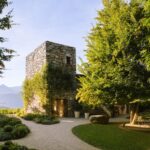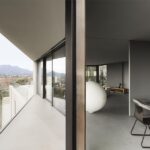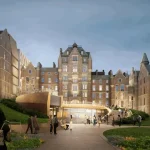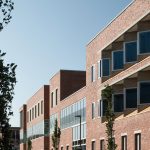Verona Borgo Trento Maggiore Hospital Building, Architect, Italian Healthcare Design, Project
City of Verona Borgo Trento Maggiore Hospital
Verona Hospital Development design by Studio Altieri in Italy
City of Verona Borgo Trento Maggiore Hospital News
New Surgery Centre
City of Verona Borgo Trento Maggiore Hospital, Veneto, Italy
Design: Studio Altieri
4.2 The floors
Floor zero: the services block
Floor zero is the operating heart of the new Surgery Centre. This floor is 50 cm above Via Lungadige, so that it is completely secured against any danger flooding by the River Adige.
This large block is completely dedicated to the most specialised diagnostic and treatment services and is divided into five sub-blocks corresponding to accident and emergency, operating unit, diagnostic imaging, blood transfusion and sampling centre, and test laboratories.
Accident and emergency
This is situated on Via Lungadige and is linked by a lift to the emergency heliport on the roof. It is organised in two areas according to the severity of the particular emergency: a surgery area (with shock room, rooms for minor operations and diagnostic imaging) and a medicine area with examination cubicles and a reception/observation ward.
The accident and emergency department is designed and equipped for quick adaption to cope with catastrophic events and large influxes of patients.
Operating unit.
This is situated next door to Accident and Emergency and has a vertical link with floors of the Surgery Centre, which contains intensive care, the day hospital and normal wards.
The 32 operating rooms are grouped into four blocks, with one block of six rooms dedicated to day surgery.
Some rooms can be equipped for operations using robots.
Diagnostic imaging
Diagnostic imaging is positioned to the right of the operating unit and occupies the first portion below the park. It is divided into two halves according the type of use: for inpatients on the left and for outpatients on the right. The latter half can be reached from the entrance overhang via two escalators and a lift. Diagnostics for outpatients cater for traditional X-rays, CAT and NMR scans, ultrasound investigations.
Inpatient diagnostics comprise traditional X-rays, ultrasound scans, angiography, CAT and NMR scans, haemodynamics, IMRT and stereotaxis.
Blood sampling and transfusion centre
This is linked with radiology for outpatients, and shares the same entrance. It contains the blood sampling and transfusion centres.
These two centres have their own reception areas and individual cubicles for taking blood and dedicated services.
Test laboratories.
The last part of the block is occupied by the testing laboratories dedicated to clinical chemistry and haematology, microbiology and virology, and the skin and bone banks.
The laboratories have been designed in modular form so that they are highly flexible, with technical equipment rooms situated at regular intervals and movable partitions.
Floor zero is linked to the existing buildings via underground passages and lifts to other levels. This means that transport of patients and goods is invisible from the outside.
All working and waiting areas have natural light coming from the courtyards in the park.
The entrance hall
The entrance hall of the new Surgery Centre is the centre of the project: it is the arrival point of the sequence of spaces that, starting from the entry point, leads to the inside of the hospital.
The entrance hall for the public is divided into two parts.
The first part has the entry on a level with the park.
Designed as a large gallery, it has the information desk and the entrances to the outpatient clinics.
At the same level, but on the opposite side of the entry point, there is the entrance to the services block via two escalators and a glass elevator.
These lead to radiology services, the blood sampling and transfusion centre for outpatients who, in this way, do not have to enter the actual body of the hospital. Here is a link for ultrasound machines.
The second part comprises the vast hall in the inpatient block. This is reached via a staircase and two glass elevators.
This part of the project is a great innovation with respect to traditional hospitals: a vast square space, two floors high, the result of designing the building with a courtyard, and lit by five, 8 m square skylights.
This constitutes the first hospital-patient interface and must, therefore, provide reassurance and guidance.
It has been designed to resemble the lobby of a grand hotel with additional spaces for the public, such as small shops, a bank, the appointments booking centre, a bar and self-service restaurant, and a small nursery.
The ceilings, mostly in glass, and the windows towards the gardens continue the link with the outside, bringing in changing light and shade as the day passes.
Taking care to provide natural light is a help in preventing people who pass through this area from feeling part of a completely artificial “machine”.
The extensive, transparent space also helps visitors to find their way around the hospital by keeping this “piazza” as the ideal point of reference.
At the four corners of the hall, where there are information points with terminals, there are lifts and stairs to take visitors to the four upper floors, where one is for intensive care and day hospital and the others are for normal admissions.
It is also possible to reach Accident and Emergency directly from the hall via a staircase and lift, and an outdoor staircase leads to the park to be created in the future, on the roof of the current staff car park.
Great care has been taken in designing this area: the predominant materials are marble for the floors and wood for the fittings of the shops looking onto it. Colours and light are warm and friendly.
Tables and waiting areas are scattered around the hall, the central well also being enhanced by pot plants.
The outer ring of the entrance floor is occupied by doctors’ offices and all the operational units of the surgery complex, which are grouped together in a single area in order to encourage positive relations between departmental-type and inter-disciplinary operational units.
The inpatient floors
The three floors comprising the wards are characterised by large glass picture windows, 3.2 metres wide and 2.90 metres high, at intervals following the (four metre) structural module.
These windows are fundamental to the project and initiate a new way of designing the patient’s room.
Often, even in the latest hospital buildings, the wards are lit by traditional windows that reduce the space to a kind of tiny prison cell.
The patient passes most of the time lying in bed with no perception of the outdoor world because vision is blocked the wall and window ledge on the horizon.
Modern trends are increasingly moving towards “humanisation” of the “hospital machine”.
This goal can be achieved via two routes: the common areas project comprising the hall and waiting areas, which are an introduction to the building and resemble a “hotel” type of environment in the use of materials, finishes, lighting and colours; and then, most importantly, the wards project, which has a profound effect on the patient’s stay in the care and treatment structure.
The picture windows maintain a link with the outside world and the changing light and natural colours help the patient to feel a little less part of a machine that often operates in mysterious, seemingly hostile ways.
The glass windows are, of course, designed so as to prevent problems of intense sunlight and heat dispersion.
Thermal break aluminium frames are used with glass providing high levels of sound and heat insulation.
On the outside there is a kind of overhanging balcony that, with the aid of three inclined brise soleils in aluminium, creates a shadow effect that almost completely eliminates direct sunlight.
Further protection, to ensure a darkened room when necessary, is provided by an external Venetian blind on metal guides, which can be adjusted electrically from the inside.
Rooms are divided into three parts:
– the vestibule : the door space, set back from the corridor, and the bathroom which, with the corner bevelled at 45° makes it easier for care personnel and doctors to see inside the room from the corridor.
– the bed space: fitted with highly specialised equipment and materials
– the sitting area: the space near the window where the ceiling is lower but, above all, the materials suggest a more friendly, family atmosphere.
This is where the patient can eat, read or just sit and enjoy the extraordinary view from the large window.
5. Green areas
Outdoor layout
The system of green areas at the Maggiore City Hospital has undergone changes as the original hospital buildings have been transformed and enlarged, but it has managed to preserve its character as a force that unifies the site and defines its identity.
The distinctiveness of the site comes from the close relationship between the hospital system, with its buildings differentiated by formal-distributional type, and the system of green areas that was originally designed to provide a unifying vision as a park.
The new surgery complex presents an opportunity to improve the whole Maggiore Hospital park, reorganising the various spaces according to their various functions (definition of ambit types) and, as a result, re-designing the layout of green areas for each ambit.
During the first phase of the works, the central park, the linear gardens and the green areas for the new Surgery Centre will be created, while the “romantic garden” and improvement of the inner courtyards and urban boundary areas will be postponed to a second phase.
The central park constitutes the new focal point of the Maggiore Hospital, creating a direct dialogue with the main entrance looking onto Piazzale Stefani.
It is the largest green area and comprises a number of elements, each with its own individual character: the wisteria pergola, the roof garden, the basement gardens, and the water ponds at the entrance.
Water is the element providing the first approach to the hospital structure: the ponds become the new hospital entrance.
This provides a softened entrance to the hospital structure, with the running water creating a sense of serenity. The pond is crossed by a stone path, at the entrance to the park and leading directly to the entrance of the Surgery Centre.
The pergola acts as a frame to the central park and forms a pedestrian link between the main entrance and the new Surgery Centre. It will comprise a wisteria-covered colonnade above a path in Lessinia stone.
The roof garden is passage area to other parts of the hospital, but most of all it is conceived as place for relaxation, with a play area for children and a refreshment area.
The seats in the garden are reached by crazy paving paths in Lessinia stone.
From the roof garden there are views of the areas below, where there are basement gardens for the departments on that level.
The roof of the entrance to the new Surgery Centre will also be a green area covered by numerous varieties of fern.
The linear gardens are green bands at the edges of the long avenues along the sides, starting from the Piazzale Stefani entrance and leading to the departments at the far end of the hospital complex.
The project plans to widen the two bands of green, in order to enhance the effect of the existing trees by planting more trees and bushes and to complement efforts to soften the effect of the new surgery complex.
6. Construction
The works are planned to take place in 3 phases:
Phase 0 – preparatory works –
Preparation of the construction site area requires two important interventions:
• Formation of an “integrated main technical services unit” to be realised in the area presently occupied by just the electricity substation: this will contain a new central heating plant and the refrigeration plant, the co-generation system, the oxygen store, general control room and workshops. These works will marginally affect the existing technical services networks, and allow them to remain in service until the new structure is completed.
• Upgrade of the technical services distribution network, mainly using the existing system of underground passages.
Upon completion of these preparatory activities, the construction site area is to be handed over, free of all restrictions, while healthcare activities are able to continue with no significant interference.
Lastly, access to the construction site is to be located on the Lungadige Attiraglio road, which is able to tolerate the heavy vehicle traffic required by such an important construction project.
Phase I -construction of the surgery centre –
The first phase will comprise construction of the surgery complex, of the outpatient clinic building and of the first part of the services block (radiology and laboratories).
Phase II
On completion of phase I and after inauguration of the operating rooms, intensive care services, accident and emergency dept. and radiology, completion of the services area can begin.
Phase II also includes a series of works to renovate and extend the existing historic buildings left empty after transfer of all current surgery activity, in order to unify all medical specialisations.
A new visitor’s car park will be built for integration with the Piazzale Stefani system, and the current underground staff car park will be enlarged.
Lastly, the technical and hospital supplies services will be completed (kitchens, canteen, laundry, sterilisation centre, waste disposal area, workshops,….).
7. Art in the hospital
Using the various means of expression at its disposal, art has always enriched and nurtured a culture that is sensitive to aspects that are able to interact creatively and positively with spaces destined for treatment and care and that tries to transform them for use as therapeutic tools and opportunities as well as for improving the working environment.
The principal goal is to abolish the anonymity of the common areas in the hospital and in this way contribute to the process of humanising the environment (one of the requirements of the ten guiding principles for designing hospital structures).
A further objective is to alleviate the monotonous colours and emotions typifying the hospital environment, making it possible for patients and their relatives to face even difficult moments with greater tranquillity.
Inserting evidence of artistic work in the hospital can help people to relate to themselves and to their illness, thus contributing to creation of a psychological space that is more inclined towards the reconstruction of a shattered equilibrium.
What is more, temporary exhibitions are a continuing opportunity to inform users and patients and involve them in an ongoing, stimulating educational process.
Ultimately, the purpose is to fight feelings of alienation and isolation by using contact with artistic objects to stimulate a sense of regeneration. If it is possible to see something (an image, a line, a journey into a colour) that draws the mind into an imaginary world, this can recreate that vital symbiosis between mind and body that is behind every successful therapy.
The project has taken account of the need to find a new way of seeing this world, a way that is softer, more transparent, less aggressive, with more open spaces, with more silence for listening out for a dialogue between ethics and aesthetics, taking the starting point as a new vision of the sick person, of times and spaces for the hospital stay, where there has been constant attention to the interaction between the environment, the well-being of the patients and the working conditions of all the staff.
Verona Borgo Trento Maggiore Hospital New Surgery Centre images / information from Studio Altieri 240209
Location: Verona, Italy, southern Europe
Italian Architecture Designs
Contemporary Italian Architectural Selection
Italian Architectural Designs – chronological list
Verona Borgo Trento Maggiore Hospital – main page with images
Another Italian hospital by Studio Altieri:

image from architect
New Mestre Hospital : World Architecture Festival Awards 2008
Health Category Finalist
New Banca di Credito Cooperativo Auditorium, San Cataldo, Sicily
Design: FABBRICANOV
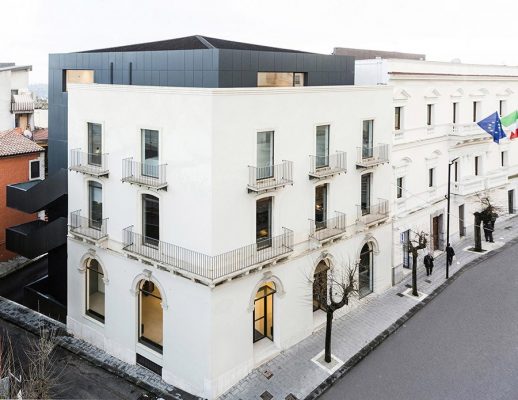
photograph : Filippo Romano
New Auditorium in San Cataldo
New Centre to assist Community After October 30th 2016 Earthquake, Perugia, central Italy
Design: Stefano Boeri Architetti
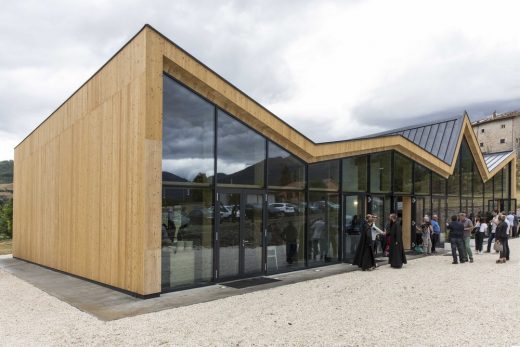
photo : Giovanni Nardie
Multifunctional Centre for Norcia, Perugia
Buildings / photos for the City of Verona Borgo Trento Maggiore Hospital New Surgery Centre Italy Architecture page welcome

